 French Navy – Standard 1500t destroyers, 14 built 1925-1931, in service until 1952: Bourrasque, Cyclone, Mistral, Orage, Ouragan, Simoun, Sirocco, Tempête, Tornade, Tramontane, Trombe, Typhon
French Navy – Standard 1500t destroyers, 14 built 1925-1931, in service until 1952: Bourrasque, Cyclone, Mistral, Orage, Ouragan, Simoun, Sirocco, Tempête, Tornade, Tramontane, Trombe, TyphonNew cycle: French Destroyers. Part I: The interwar classes, from Chacal to Le Hardi. Part II (2026): WWI French destroyers.
The Bourrasque class is a series of twelve torpedo boats of the French Navy (1923 batch) and entered service from 1926 to 1928. Each unit is named after a wind. The 26 “contre torpilleurs” known collectively as the “1,500 tons” and “three pipes” were the first French destroyers built after the First World War. They belonged to two practically identical classes, the 12 Bourrasque and the 14 L’Adroit. They were contemporary (but slightly more powerful) compared to the earlier British destroyers Class V and W. Two modified units were built and delivered to the Polish Navy under the name of Wicher class, ORP Wicher and the ORP Burza. The first was lost during the 1939 campaign but the second served with the Free Polish Navy in WW2. #frenchnavy #marinenationale #destroyer #contretorpilleur #ww2 #interwar #operationtorch
Summary
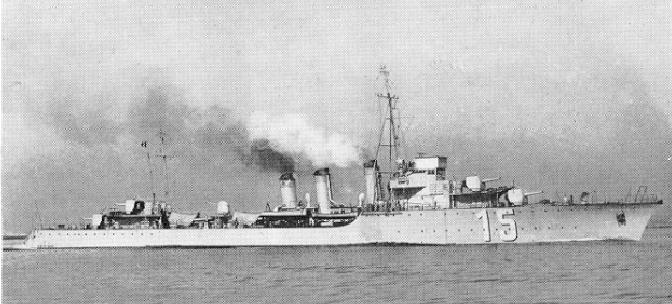
The destroyer Ouragan (“Hurricane”)
The Bourrasque class was an important class of French destroyers built in the mid-1920s. These ships, also known as contre-torpilleurs (large destroyers or flotilla leaders), were designed to accompany the French fleet and provide strong offensive capabilities. They were among the first modern destroyers in the French Navy, and their design influenced subsequent classes like the L’Adroit class. The Bourrasque class was part of France’s efforts to improve its naval fleet after World War I, addressing the need for versatile, multi-role ships.
They measured around 105. meters (344 feet) for a beam of 9.7 meters (32 feet), a displacement of Approximately 1,500 tons (standard, hence their classification as 1500t class DDs) and 2,000 tons (fully loaded). Their design emphasized a high speed with a narrow beam, making them relatively fast but less stable in rough seas. They were capable of 33 knots (61 km/h or 38 mph) in favourable conditions, for a range of Approximately 3,000 nautical miles at 15 knots, a respectable range for its time, allowing for operations in both the Mediterranean and Atlantic.
They were armed with four 130 mm (5.1 in) guns mounted in single turrets, for a decent firepower against surface targets (120-127 mm was standard at the time). For AA defence they carried two 37 mm AA guns and two twin 13.2 mm mounts. They also had two triple 550 mm torpedo tubes, and two depth charges racks, but later in wartime, received DC throwers.
Intended for fleet escort duties, anti-submarine patrols, and torpedo attacks they were designed to engage enemy destroyers and larger ships with torpedoes, while also providing defense against submarines. Bourrasque was the lead ship, notable vessels were Cyclone, Orage, Ouragan, and Simoun. They saw action in the early stages of World War II, particularly in operations related to the German invasion of France in 1940. Three were lost in combat in 1940, one scuttled to prevent capture, two destroyed during Operation Torch in Nov. 1942 and some taken over by the Germans and Italians after France fell. They helped establish the blueprint for later French destroyer designs, focusing on speed and multi-role capabilities.
Development
The legacy of WWI
The genesis of destroyers up to the first world war was a fertile background on which to built new designs. Prior to WWI, France had a mix of destroyers and sea going torpedo boats, evolved for Jeune Ecole torpedo boats, quite fast such as the 30+ knots Forban of 1895. They were still fairly small at 150-180t. The destroyers built until 1909 were also small vessels between 300 and 350t, were low and flush-deck with four funnels, but still used VTE engines, 65 mm guns and 450 mm torpedoes. The game changers were the Bouclier class or “800-tonners” built from 1910. They had a forecastle, steam turbines and a 100 mm gun as well as more torpedoes.
The next class built and improved on that design but manpower and resources limitations meant only a handful of these were available when the war broke out. By requisition of four ships intended for Argentina (Aventurier class, launched in 1911) the French introduced their larger design (930/1260t FL) so far. The lack of modern destroyers even led to purchase an additional class of ten vessels… to Japan, the Arabe class. These were a modified Kaba designs and remained in service until the mid-1930s. They were still small at 685t but a valuable design nonetheless, especially for range.
The study of War Prizes
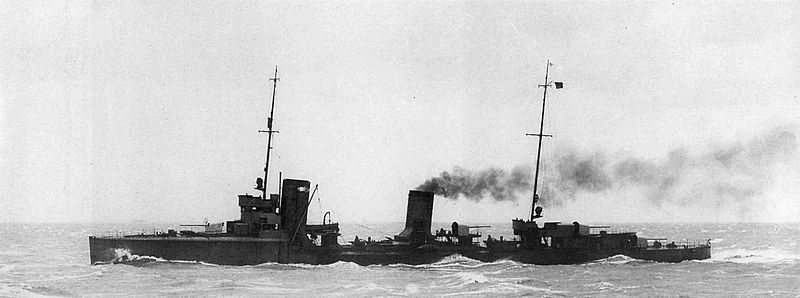
S113, perhaps the best German design of late WWI (here in German colors)
Nothing was more instructive than the study of foreign destroyers to continue working on improved designs, despite the complete stop of any naval construction (but small ships) in France virtually during the whole war from 1914 to 1918. All resources and manpower was dirtected away from shipyards and to newly built ammunition and tanks factories. Aside the 450, 850t, 930t and Kaba-type series still in service until the 1920s or 1930s, France also obtained a number of ex-central empire navies as war prizes. Matelot Leblanc for example was the ex-Dukla (Tatra class), Pierre Durant, Chastaing, Mazaré, Vesco, Deligny, R.de la Touche, Delage, Sénès sampled the German V and S classes in 1920, between 920 and 990t. They were of the “toothbush” type Hochseetorpedoboote.
But none was more instructive than S-113 (which was renamed Admiral Senes). This brand new 1918, 2060t design was among the largest and best German designs ever produced, a true game changer. They had two twin tubes of 500 mm but overall four 150 mm guns, something unheard of for a destroyer, and which prompted the RN to design new flotilla leaders and the V-W classes.
However on trials, if it was fast and well armed, the S113 also showed its poor seakeeping qualities and how these large guns could make it top-heavy. Calculations showed that to keep such armament, far more buoyancy was necessary, hence a 3500 to 4000 tonnes design. Also the 15 cm caliber was too unwieldy for quick firing and the French started to think of an intermediate ordnance between the common 120-127 mm and this cruiser standard. On the other hand, the disappearance of torpedo boats, unable to perform in high seas, and the new flotilla leaders led to a reflection in 1920-22 and eventually the adoption of a double standard.
Double standard: Torpilleurs & Contre-Torpilleurs
To better cover the needs of the fleet, especially in the Mediterranean the primary theater for the postwar French Navy, especially after the de facto rivalry with Fascist Italy from 1922 compounded by the Washington treaty a year later, it was decide to create two “destroyers” standards. The “torpilleurs”, which were destroyers of all but name, larger than any previous models, with good seaworthiness for fleet operations, and tasked of escort and torpedo attack, hence their name. On the other hand, the “Contre-Torpilleurs” were inspired by flotilla leaders, and intended to hunt down and destroy adversary’s own destroyers. They were much more powerful in size, speed and armament. They were intended to scout for the fleet as well almost as an independent arm, not to stick to a combat group. They also capitalized on more lenient conditions for destroyers as designed by the Washington treaty compared to cruisers. They also answered some concerns about Italian own leaders such as the Peorio, Leone or Mirabello.
So for the torpilleurs, the specs were ready rapidly in 1922 for a funding of the first ships FY1923. The first “contro-torpilleurs” were started a bit earlier, laid down in 1922 already. It was agreed upon a 1500 tonnes design as standard (normal load), two triple 550 mm torpedo tubes, and four main gun of intermediate caliber, 5.1 inches or 130 mm for a top speed of 33 knots and a range better adapted to the Mediterranean. Compared to their contemporaries, it seemed reasonable. In fact the class, caracterized by its three funnels, was considered successful enough to be virtually repeated for the next L’Adroit class (1925-30).
The L’Adroit class were however built after a significant delay to take in account recent developments in capital ships (The Dunkerque class, and the Richelieu class in construction) and it was agreed a new standard with higher speed, range, and better, dual purpose armament, leading to the L’Adroit class (1937-41). So the French “torpilleur” category in the interwar is simple and straithforward. This did not prevented the Marine Nationale to opt for “true” torpedo boats though with the Melpomene and Fier class, taking advantage of the 1930 London treaty concessions, and recoignizing Italian efforts to design new, modern torpedo boats. They were not without merit to fill some capacity gaps in the confined waters of the Mediterranean.
Design of the class
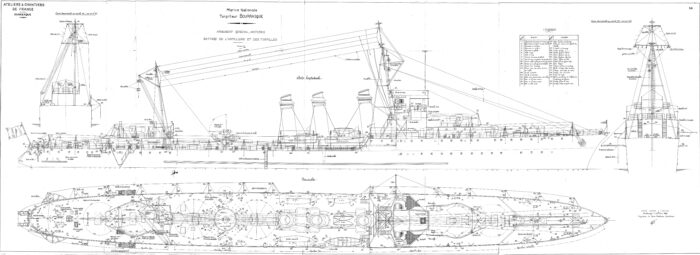
These first interwar “standard” destroyers (called torpilleurs) of the French ordered under the 1922 programme, first postwar major French Naval program also comprising the Jaguar (Chacal) class and Duguay Trouin class cruisers. They looked a bit archaic with their three-funnel profile, and had a unusual round inverted stern. However when they had their keel laid down in 1923, they had the strongest destroyer artillery of her time, plgues however by a slow firing rate. As escorts they left to be desired without hydrophones albeit they received depth charge racks and throwers. Their AA artillery was also weak. They started to be modified in the mid-1930s for stability. Funnels were shortened. Wear and tear of their machinery led to speed losses. In the 1920s they were only capable of 30kts at full load, and and were down to 28-29kts at best in 1939 whereas many destroyers of her time were capable of 36 knots even fully loaded. The “trois tuyaux” (“three pipes”) were unpopular also for their excessive roll. Some measures had to be taken later to regain stability, and they had very little room for upgrades.
Hull and general design
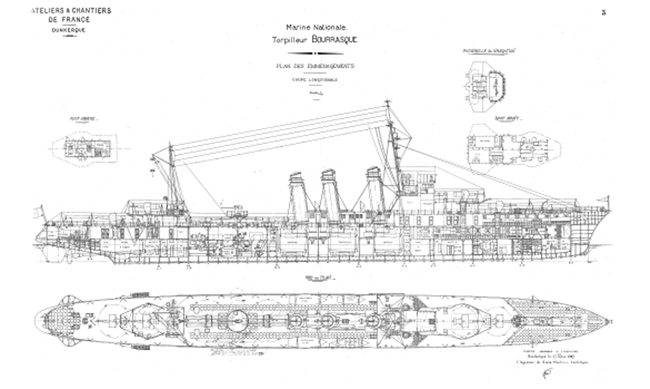
1 2 3 4 5 6 7 8 9 10 11 12 20 26 29 30 45
The Bourrasque class measured overall 105.6 meters (346 ft 5 in), which was on the rather large size even for a standard destoryer, for a beam of 9.7 meters (31 ft 10 in) making for a near 1/11 ratio, and draft of 3.5 meters (11 ft 6 in). Displacement was 1,320 metric tons (1,300 long tons) on standard Washington load and 1,825 metric tons (1,796 long tons) deeply loaded. The Washington treaty gave a global destroyer tonnage, but did not defined a max tonnage. This was done however on the later London treaty, specifying a destroyer to be a maximum of 1,850 long tons (that means standard). There were exemptions for destroyers leaders however, which France used for its own “contre-torpilleurs” (CT). Max caliber was defined following the French upper limit of 5.1 in (130 mm). Again, French CTs were an exception as flotilla leaders, having 5.5 in guns (140 mm).
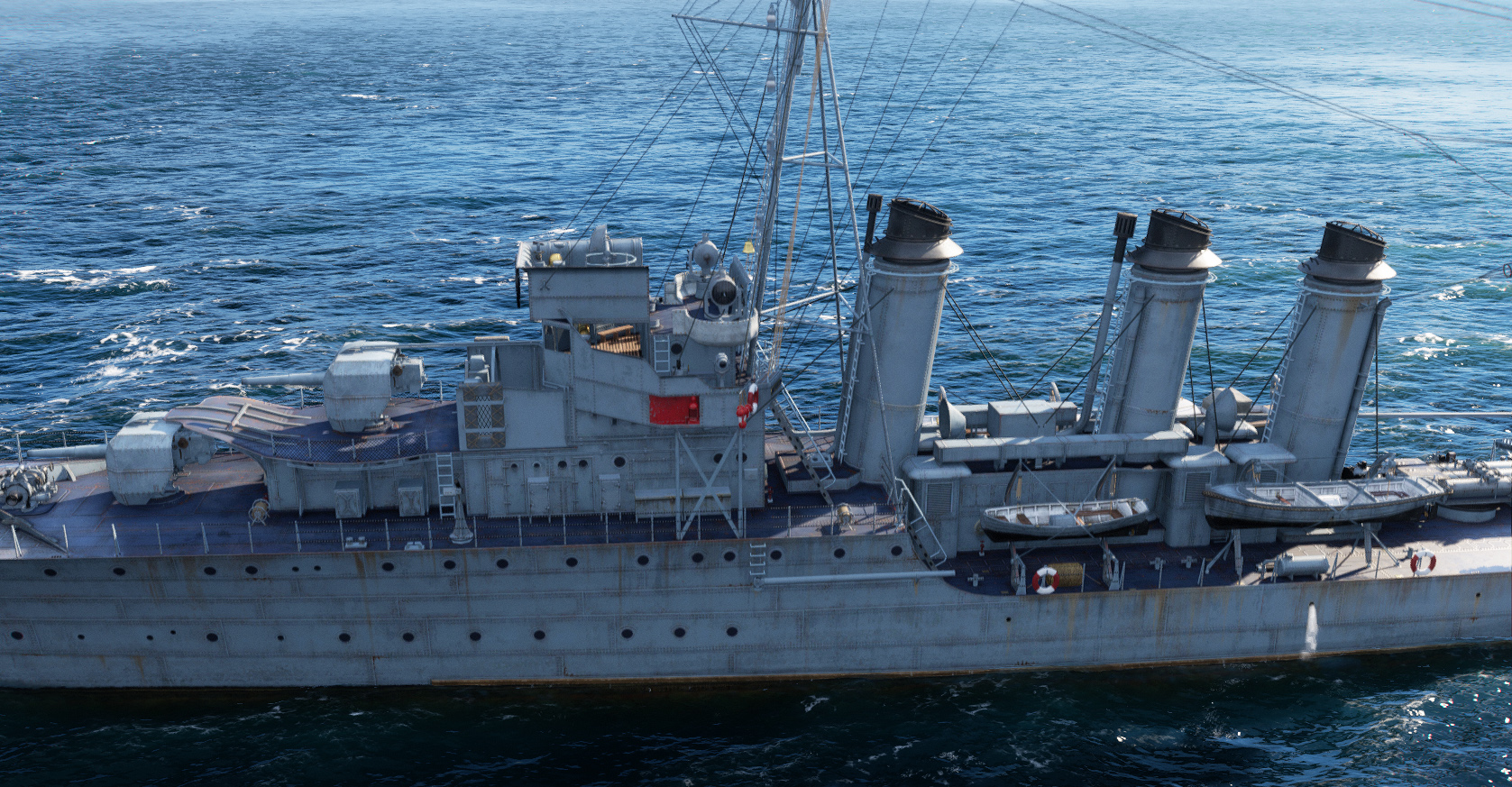
WoW’s rendition – View of the bridge
Design-wise, these destroyers were graceful, still. Unlike WW1 destroyers, they had a good seaworthiness dur to their higher forecastle with a slanted bow and much flare to stay dry as much as possible. The forecastle lenght ratio was roughly 1:1.6 for the whole hull so it was quite long and ended with an Atlantic clipper bow. Stability was an issue straight away as A and B gun mounts, heavier than standard, were placed in a superfiring position, for the first time in a French destroyer. The squat navigation bridge followed behind, towering over “B” position, and topped by an open firing control bridge with repeated command and voice pipes. The bridge wings made a triangle, ending nearly as large as the weather deck and supported by pillars. The radio room was immediately aft, below the wheelhouse in which was located the bar, and machinery indicators.
The wings included navigation red-green lights in recesses. Unlike common practice, the two searchlights were not in upper platforms in the axis but both on either side of the bridge’s rear upper deck, with limited angles on both sides. There were two access ladders aft of the bridge’s deck. Two masts, with the foremast being the lattest, and tripod, with cross beams, supporting a spotting top and wireless telegraphy cables anchored forward and on the shorter aft mainmast. Both were raked as were the three funnels.
On both sides were located services boats, four in all and of different size and role. There was a whaler, a pinnace, and two motored cutter aft.
Then came the two torpedo tubes banks aft amidships and in between the free space was used to install a platform supporting the main 75 mm AA gun, having a good arc of fire, albeit somewhat curtailed by the tall funnels forward. Crew quarters were installed in the forcastle as customary, but the bakery, galley, and drying room were located between funnels.
Then came the aft quartedeck structure, with X-Y superfiring mounts. The poop as said earlier was very peculiar and proper to French destroyers. It was studied to drop depht charges (carried internally) and avoid them hitting back the hull. So the poop was round seen from above, but edgy seen from the side, trapezoidal, with its inferior face c50 cm clear off the waterline, and going down to the lower hull along a long curve down to the keel. Waterlines were narrow forward with sheer and flare for the bow above and weather deck. About 1/3 of the section amidship was occupied by machinery, with the three separated boiler rooms and the steam turbines room behind. A voice pipe was installed high up, running all the way from the bridge and wireless room behind the bridge, to the quartedeck house aft. The commander’s cabin was located aft, below the officers quarters in the quartedeck house, the mess and officer’s galley was located in the structure and officer’s cabins undee “Y” deck gun. This was an inheritance of old designs that was later corrected as officers needed to be closer to the action and relocated in or below the bridge.
I could go on and on on these details, just check the plans for more.
Powerplant
Perhaps not the best feature of these destroyers, the machinery was a bit underpowered. There were two three-bladed bronze propellers on shafts driven by two geared steam turbines (see below). They were fed by steam provided by three du Temple boilers. These turbines were designed to produce 31,000 metric horsepower (22,800 kW; 30,576 shp) or 33,000 shp in others sources, but this varied between types (three):
Indeed Typhon, Tramontane, Tornade, Trombe had Zoelly geared steam turbines whereas Simoun, Cyclone, Tempête, Mistral, Bourrasque, Siroco had Parsons geared steam turbines, and Orage, Ouragan had Rateau-Bretagne geared steam turbines.
Contracted speed was 33 knots (61 km/h; 38 mph), apparently obtained on trials, on light load. However it degraded over time. The ships carried 345 tonnes of fuel oil for a range of 3,000 nautical miles (5,600 km; 3,500 mi) at 15 knots (28 km/h; 17 mph) or 2,150 nm at 14 knots depending on sources.
As said above, all three boiler rooms and the turbine rooms were separated by light bulkheads, enough to stop predictible levels of flooding.
Armament
The strong point of the design as “standard” destroyers went. Like the immense majority, they had four main guns, two triple torpedo tubes, one AA gun, machine guns, and depht charges. However unlike everybody, caliber was superior to contemporaries, bioth the main guns were 5.1 inches or 130 mm versus 120mm+, but the torpedo tubes had the 550 mm caliber instead of 533 mm.
Canon de 130 mm Modèle 1919
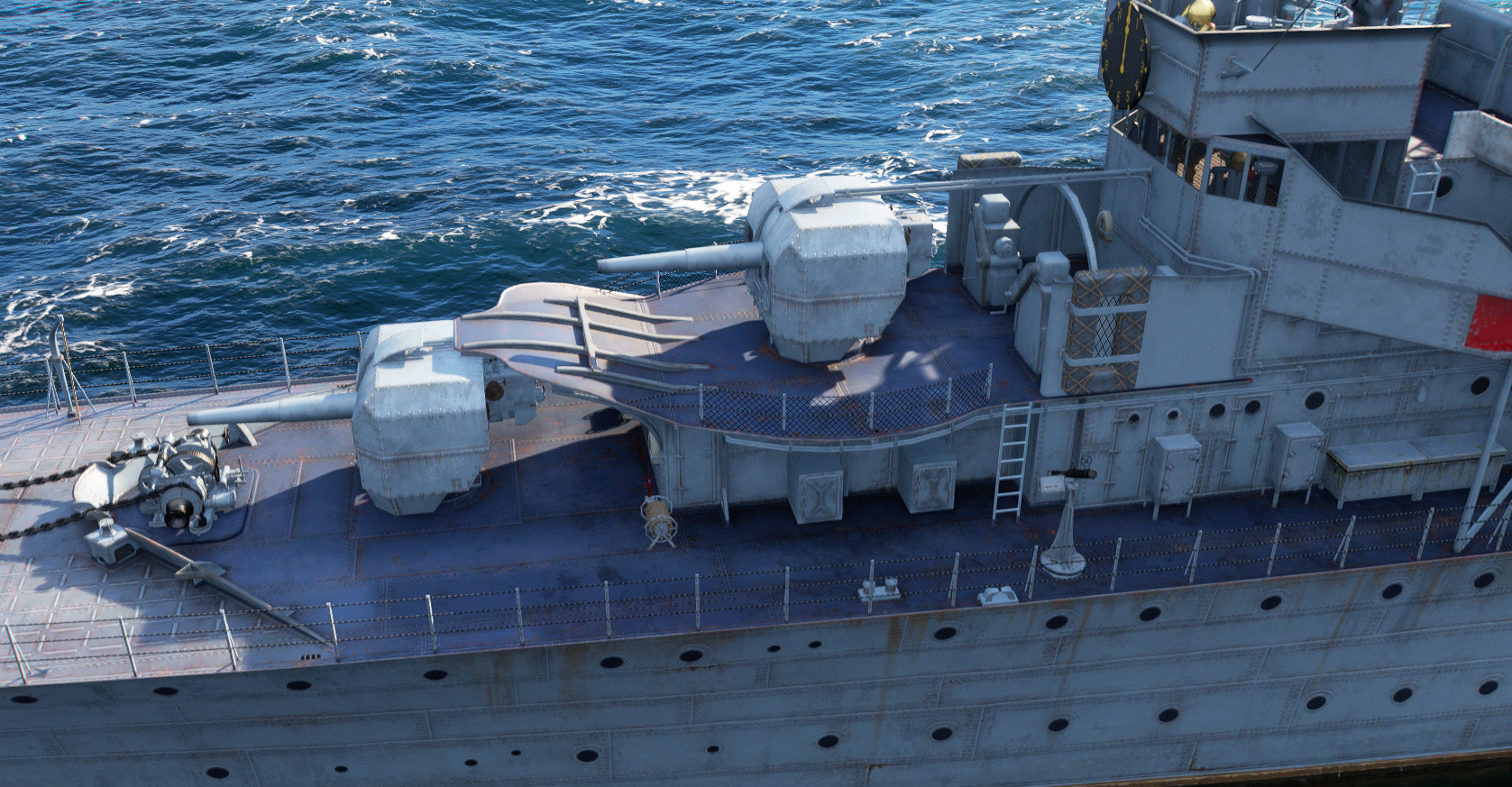
Forward turrets and reloading system
These were of built up construction, with Welin breech block, carrying low-angle single turrets.
They used separate QF ammunition with a cartridge case was 674 millimetres (26.5 in) long, weighting 7.73 kilograms (17.0 lb) wuth an added propellant charge of 17.5 kilograms (39 lb) so a combined weight while in the breech of 25 kgs. The crews were quickly tired and rate of fire was slow at 4 rpm, 5 with very fit, fresh and well trained gun crews. They could fire the Semi Armour-Piercing 32 kg (71 lb) round, a classic High Explosive of 34.85 kg (76.8 lb) and Illumination shell, but no AP round. Velocity was average however range was excellent at nearly 20 km, albeit fire control was archaic. The model was replaced for the later classes, onky used by the Bourrasque and Chacal (Jaguar) class.
⚙ specifications 5.1 inch Gun
Mass: 3.35 metric tons, barrel 5.2 meters (17 ft) 40 cal.
Shell: 130x674mm R Separate loading QF 35 kgs (77 lb)
Elevation -10° to +36°, 4-5 rpm, MV 725 mps (2,380 ft/s)
Maximum range: 18,900 meters (20,700 yd) at 36°.
Canon de 75 modèle 1922 Schneider
Initially, a 75 mm/50 Schneider M1922 AA gun was installed on the inter-TT bandstand. The Canon de 75 modèle 1922 Schneider was a field gun partly based on the surplus Canon de 75 modèle 1897 field gun as converted, with more made into AA guns.
Mass: 1,320 kilograms (2,910 lb), barrel 2.347 metres (7 ft 8 in) L/31.3
Shell: 6.3 kilograms (14 lb) 75 mm (2.95 in), 3-4 rpm.
Elevation: -5° to +80°, mv 600 m/s (1,968 ft/s)
Maximum range 12,000 metres (13,000 yd).
Another source states it was the modèle 1924, but it’s not related to these destroyers.
It had a far better velocity at 850 m/s and fired 5.93 kg (13.1 lb) fixed rounds instead with a cailing of 10,000 m or11,000 yds at 90° angle.
Canon de 37 mm Modèle 1925 (1931)
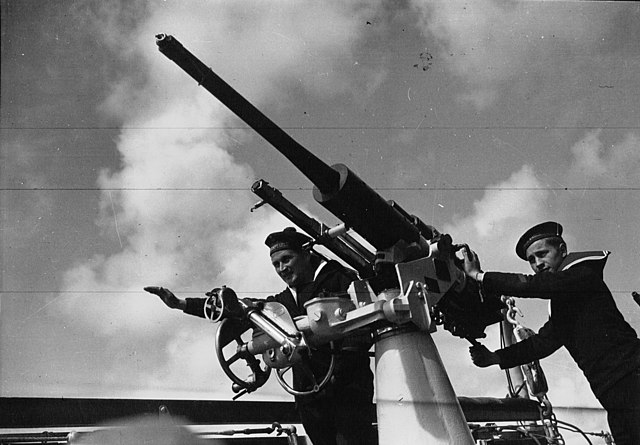
From 1931 the 75 mm was replaced by two smaller, lighter but faster firing Canon de 37 mm Modèle 1925. Two were installed in an enlarged platform. It was a single gun mount (later the twin mount Modèle 1933 was adtopted). Hand-loaded and semi-automatic guns with unitary rounds, they still had a low rate of fire compared to their clip-fed equivalents. The projectiles were also quite light and gave an overall poor anti-aircraft capability, the dark side of French naval vessels up to WW2. Many were captured by the axis and resued in WW2 under different names.
⚙ specifications 37mm M1925 Gun
Mass: 300 kg (660 lb), Length 2 m (6 ft 7 in), barrel 1.8 m (5 ft 11 in).
Shell 0.72 kg (1.6 lb) 37 × 278 mm (1.5 in)
Elevation −15° to +80°, traverse 360°, 15-21 rpm, mv 810 m/s (2,700 ft/s)
Effective range: 5,400 m (5,900 yd) at +45°, max 7,000 m (7,700 yd).
Mitrailleuse Hotchkiss de 13,2 mm
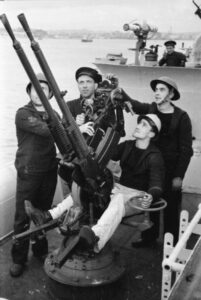 Initially the single 75 mm was completed by two 8.8 mm (0.34 in) light AA Hotchkiss machine guns located in the wings. They were removed at the same time as the “75” and replaced by two twin 13.2 mm/75 heavy machine guns. This, at least was a high rate of fire system on a light mount designed by Le Prieur. This was Gas operated system fed by 30-round box magazine, or 15-round feed strips. It was copied by Japan and Italy and used by the axis in WW2. The round was peculiar in this it was a 12.7 × 99 mm Browning (.50 BMG) cartridge necked up to 13.2 mm caliber. A short round (96 mm) was introduced in 1935. It ws mostly adopted for fixing the barrel wear issue. Hotchkiss developed also single and quad mounts, one which was studied by the US.
Initially the single 75 mm was completed by two 8.8 mm (0.34 in) light AA Hotchkiss machine guns located in the wings. They were removed at the same time as the “75” and replaced by two twin 13.2 mm/75 heavy machine guns. This, at least was a high rate of fire system on a light mount designed by Le Prieur. This was Gas operated system fed by 30-round box magazine, or 15-round feed strips. It was copied by Japan and Italy and used by the axis in WW2. The round was peculiar in this it was a 12.7 × 99 mm Browning (.50 BMG) cartridge necked up to 13.2 mm caliber. A short round (96 mm) was introduced in 1935. It ws mostly adopted for fixing the barrel wear issue. Hotchkiss developed also single and quad mounts, one which was studied by the US.
⚙ specifications 13.2mm M1929 HMG
Mass 37.5 kg (83 lbs) per gun stripped.
Length: 1.67 m (5 ft 6 in), Barrel 1 m (3 ft 3 in)
Shell: 13.2×99mm Hotchkiss Long (1929).
Elevation -10° to +90°, traverse 360°, 450 rpm cyclic, 200-250 rpm sustained
Muzzle velocity: 800 m/s (2,625 ft/s)
Max range: 7.2 km (4.5 mi), Effective 4,200 m (13,800 ft)/45°
23D/DT 550mm TORPEDOES
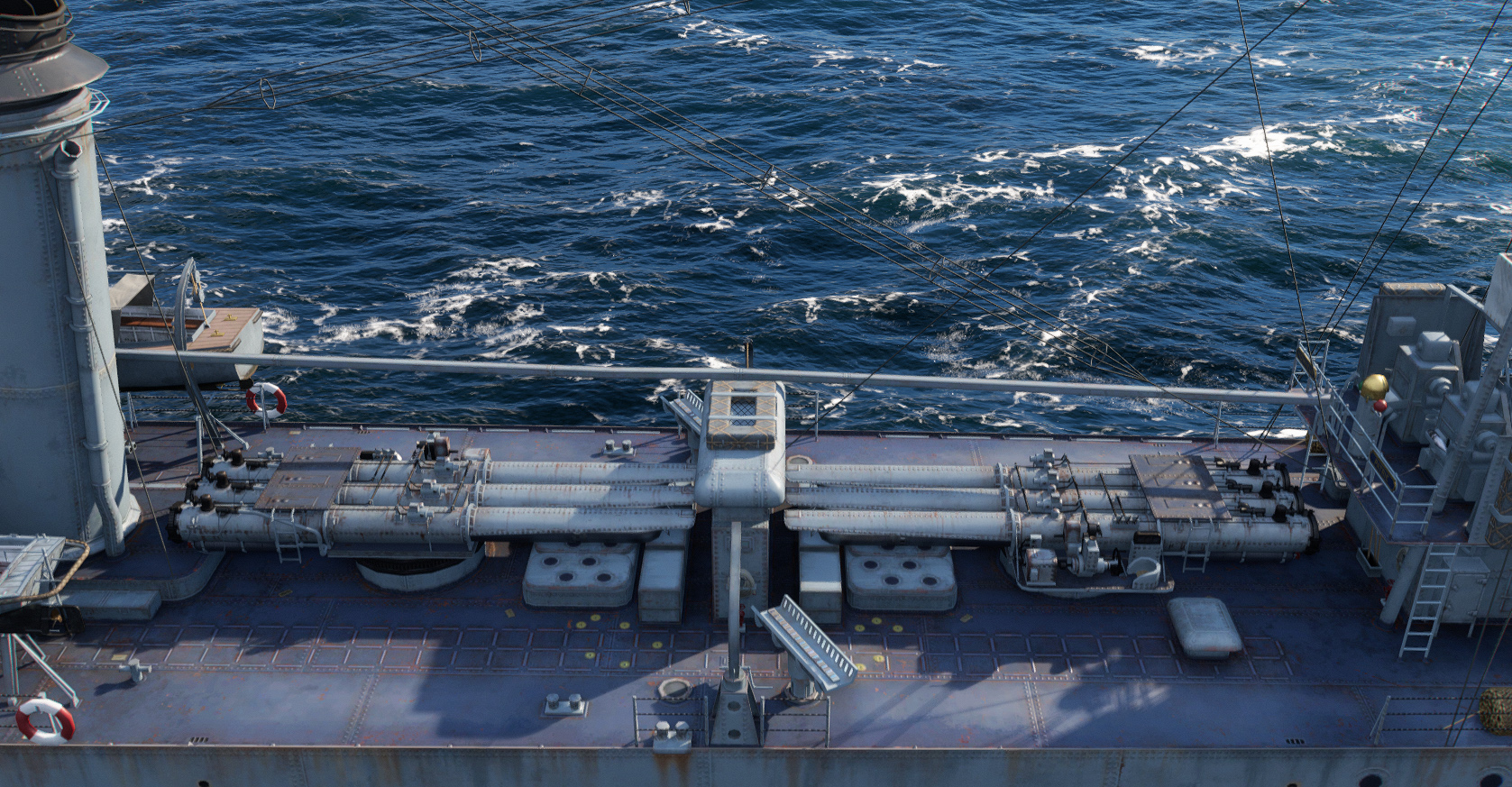
WoW’s rendition of the torpedo tubes, note the reload cradles
The French devceloped this new standard instead of 533 mm directly from WWI 450 mm standards back in 1919. The 19V entered service in 1921 and had a 4-cyl. radial engine, kerosne wet-heater for 43 knots max, carrying a 525 lbs. (238 kg) picric acid warhead at only 2,200 yards (2,000 m).
Next came the 19D designed like all the serie at Toulon Arsenal. The 19D was slower in settings at 25-25 kts but for a better range of up to 15,300 yards (14,000 m) and same tech. Needless to say, a 25 knots torpedo was only useful against merchant traffic and in the best conditions.
The first good model used on most French destouyers in the interwar was the Toulon’s 23D model, and later 23DT, declined for submarines as the 24V/24M.
The 23D was introduced in 1923 hence the name, “D” standing for destroyers, and DT for destroyer leaders. They were otherwise identical and intorduced a far more efficient propulsion, albeit speeds were average.
This was the standard torpedo also for cruisers, and active in WW2 albeit in 1940 was searched an Oxygen-powered model capable of 40-55 knots and up to 18 km or 19.700 yards. Developed became underground and stopped completely in 1944.
⚙ specifications 23D/DT TORPEDO
Weight: 4,560 lbs. (2,068 kg), for 27 ft. 2 in. (8.280 m) x 500 mm (21.7 inches).
Warhead: 683 lbs. (310 kg) TNT
Powered by a Schneider alcohol fed air heater, 4-cyl.
Speed settings: 9,840 yards/39 kts or 14,200 yards (13,000m)/35 kts
More
French Depth Charges
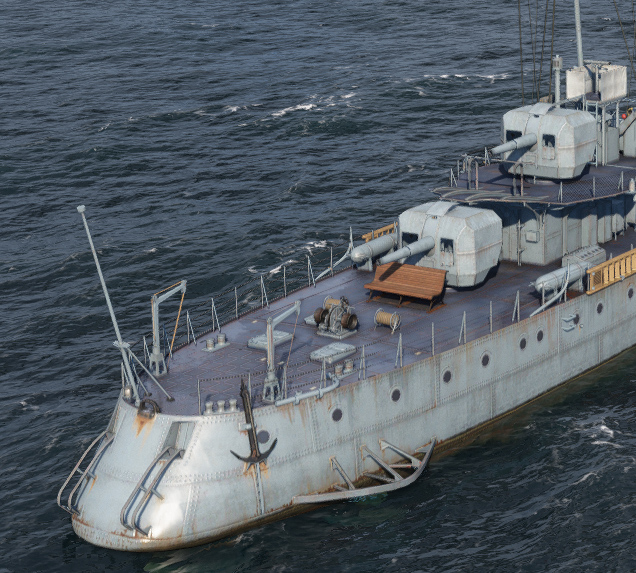
Poop’s depth charge system
Although sources diverged on this, the hull design with dedicated chutes at the poop says otherwise: These ships were given depht charges from the start, even though they only had a basic hydrophone and no sonars. These were likely the Guiraud Model 1922 200 KG.
Introduced in 1923, they Weighted 573 lbs. (260 kg) for a 441 lbs. (200 kg) charge for 50 x 88 cm (19.7 x 34.6 in).
Sink Rate or terminal velocity was 10 fps (3 meters per sec.) with 100, 165, 250 and 330 feet (30, 50, 75 and 100 m) settings, later augmented to 120m.
They were held in two Galle 12-DC roller chain racks at the poop, internal, 24 total, and two depth charge throwers on the aft weather deck. Other sources specified they carried instead 20 grenades of 250 kg, so 10 per chain rack.
The racks were the USN Mark I developed after the USN rejected the British practice, designed by Lt. Cmdr. Ishwood and dating back to 1918 with 250 American, British and French destroyers installed at V day. Larger destroyers had similar system but for 16 DCs total per rack so 32 total.
The French Y-Guns or DC projectors were WWI Thornycroft models purchased in 1918, replaced in 1930 by the French-built 100/250 M1928 mortar. Fixed on a trainable mounting it could project a lighter 100 kg DC at 820 feet (250 m). In the late 1930s they were replaced by a much heavier system firing 200 kg DC about 200 feet (60 m), so standardized with the 1922 Guiraud model.
More on this
Modifications and Modernizations
In 1931 all had their AA modernized with the single 75mm/50 AA guns and Hotchkiss single 0.3 in LMG replaced by a pair of 37mm/50 M1925 AA guns and two twin Hotchkiss 13.2mm/76 AA guns, likely located in the wings.
As the war started, the French naval command recoignised it was ill-prepared for ASW, and ordered all destroyers to be fitted with a type 123 sonar, a cheap models installed on British trawlers, ordered by the French Navy and interrupted by the defeat in June 1940.
In 1941-1942, Tornade received a single 25mm/60 M1938 whereas Tramontane lost a TT banks for an extra 25mm/60 M1938. Typhon had the same mods, but her other TT banks remaining was converted into a twin bank to spare weight.
In 1943, Simoun, Tempête, Ouragan, Mistral (1945): in Free French service lost a main gun, her two 37mm/50, and twin 13.2mm and one TT bank was removed, in exchanged for a 40mm/56 Bofors Mk 1.2, and six or eight 20mm/70 Oerlikon Mk 4 AA guns and US radars (unspecified). Mistral in alternative received four British 120mm/45 QF Mk IX, a single 76mm/40 12pdr 12cwt QF Mk I/II/V AA gun, and three Oerlikon Mk II/IV as well as a type 291 radar. Simoun later lost anther TT banks. Trombe was the only one fitted with radar in 1942-43.
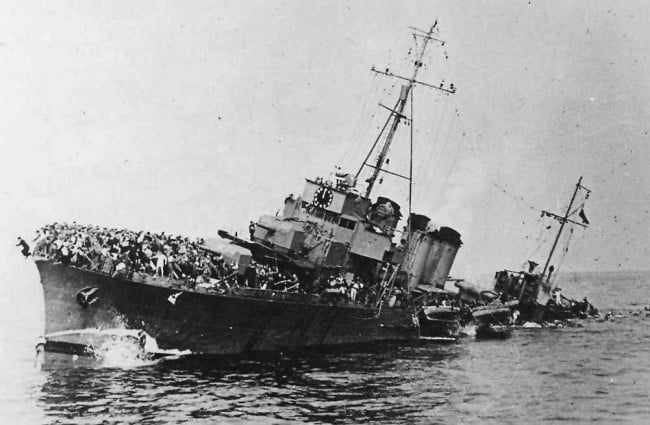
This class paid a heavy toll to allied evacuations from Dunkerque during Operation Dynamo, here a famous photo of Bourrasque going down with French troops on deck
⚙ Bourrasque class specs. |
|
| Displacement | 1,298 long tons (1,319 t) standard, 1,968 long tons (2,000 t) full load |
| Dimensions | 106 x 9.64 x 4.3 (347 ft 9 in x 31 ft 8 in x 14 ft 1 in) |
| Propulsion | 2 shafts Geared turbines, 3 boilers: 31,000 shp (23,117 kW) |
| Speed | 33 knots (61 km/h; 38 mph) |
| Range | 2,150 nmi (3,980 km; 2,470 mi) at 14 kn (26 km/h; 16 mph) |
| Armament | 4× 130 mm, 1× 75 mm AA, 4× 8.8 mm AA, 2×3 550 mm TTs, 2 DCR, 2DCT |
| Sensors | Hydrophones (1940) Radars (1943-44) |
| Crew | 7 officers, 138 men |
Career of the Bourrasque class
They reflected the sad situation the French were in. After the capitlation and emergence of the Vichy Gvt. France was officially neutral, albeit it clearly was leaning to the axis by ideology. On the allied part of the war, France lost four in Operation Dynamo (Bourrasque, Cyclone, Orage and Sirocco) in 1940: Orage on 23 May by Stukas off Dunkerque, Bourasque by mines and coastal artillery fire on 30 May while evacuating troops also from Dunkirk, Sirocco on 31 May by E-Boats also in the channel and in the same operation, Cyclone, badly damaged on 30 May by E-Boats, limping back to be scuttled at Brest on 18 June to prevent capture.
Operation Catapult saw Mistral and Ouragan captured by the British in Plymouth on 3 July 1940 and they were transferred eventualy to the Free French after Ouragan saw service for some time in the Free Polish Navy. Both survived the war.
Now Vichy France: Tornade and Tramontaine were lost off Oran on 8 November 1942 as part of Operation Torch. Typhon was scuttled in Oran harbour to prevent capture. Simoun and Tempête in Casablanca were spared the same fate as an agreement was found. They joined the Allies. Trombe was the only one present and scuttled at Toulon also in November 1942 in Operation Lila, the Gerlan invasion of the so-called free zone. She was raised and repaired, ended as the Italian Navy FR31, but never operational. She was re-transferred to the Free French on 28 October 1943 but crippled by RSI Italian MTM explosive motorboat on 17 April 1945 in the Gulf of Genoa. So even so France was out the war, most of the French Navy was sunk in various circumstances depending on an impossible and largely ficticious neutrality.
 Bourrasque
Bourrasque
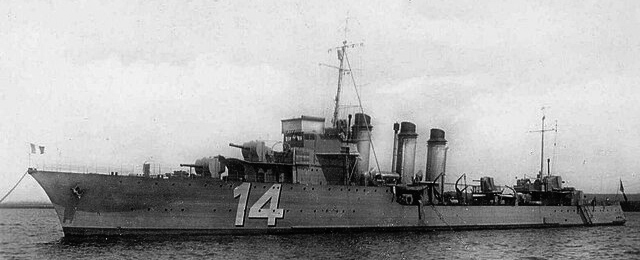
Bourrasque was laid down at Ateliers et Chantiers de France (ACF) in Dunkirk on 12 Nov 1923, launched on 5 Aug 1925 and commissioned on 23 Sep 1926, completed on 23 Sep 1926.
She hit a mine and sank Mined and off Nieuport during Operation Dynamo, 30 May 1940.
 Cyclone
Cyclone
Cyclone was laid down at Forges et Chantiers de la Méditerranée (FCM) in its Le Havre yard on 29 Sep 1923, launched on 24 Jan 1925, commissioned on 15 Mar 1927, completed on 25 June 1928. She was badly damaged by E-boat S-24 30 May 1940, scuttled at Brest 18 June 1940 to avoid capture.
 Mistral
Mistral
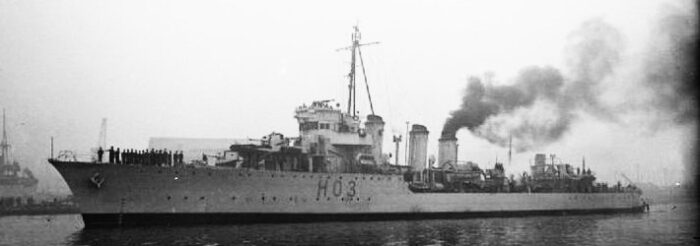
Mistral was laid down on 28 Nov 1923 at FCM, launched 6 Jun 1925, 5 Apr 1927, commissioned on 1 Jun 1927, completed and in service on 21 Jan 1928.
In June 1928, she took part in the largest French naval maneuvers since WWI in the Atlantic. On June 29 she was in Le Havre harbor for the “nautical week” organized by the Colonial and Maritime League. On July 3 he squadron was visited by President Doumergue, and Navy minister Georges Leygues. In April 1929 she escorted Strasbourg with Mistral to Corinth for victims assistance after a violent earthquake. From 1936 she was in the 6th Torpedo Boat Division, patrolling the Spanish coast during the civil war with sisters Cyclone and Siroco, and they were in overhaul modernization from november 15, 1937. Until then they had cranked up some 21,000 nautical miles since the start of 1937 alone.
From September 3, 1939 they remained in the 6th TBD in Brest, Mistral having the penant T63. From September 3, 1939 to May 1, 1940 she escorted no less then fourteen convoys between Brest, Verdon, Gibraltar and Casablanca.
On October 15, 1939 she was in the rescue mission of the cargo ship Vermont when seeing the trail of a torpedo, an spotted the origin point of the U-boat. She made three DC passes and finished off U-45, previously damaged by HMS Inglefield. On October 28, 1939 with Chacal she escorteds a British convoy to Gibraltar (OG4), spotting and attacking an U-boat, no apparent result. On March 31, 1940 in the Mediterranean she escorted 14 ships when reported by the sloop Amanite a periscope. She ran to the spot and dropped eight DCs, no results.
On the Night of May 20-21, 1940 she rescued crews of the Pavon and Niger. Too exposed to the Luftwaffe, Dunkirk started an evacuation in which the 6th DT took part. They escorted the tanker Niger out of the port in a very clear night, full moon. The Luftwaffe attacked, the tanker was hit twice and caught fire, evacuated. The 6th DT saved 111 of the 114 crew, and she was finished off by S-Bootes. She rescied men from the Pavon in the western channel as well.
In May 22-23 she supported the defenders of Boulogne. At 07:45 with Cyclone and Siroco she open fire on a column of the 19th Panzer Korps, spotted advancing on the coast and dispersed a platoon of enemy tanks. At 09:45 Crèche Fort fell. At 11:30they were joined by HMS Vimy, Leopard, Chacal, to bombard the fort. At 13:30 Fougueux and Frondeur joined the party. Meanwhile the 21st Infantry Division opposed the enemy advance. German batteries were deployed on the shore and started to target Mistral. But her fire was deadly. The 2nd Panzer reported progressing only slowly, taking heavy losses.
On May 29, 1940 she took part in the evacuation of Dunkirk, running at 24 knots and shelling a German battery near Nieuwpoort. She moored at 3:00 p.m. at the Embecquetage quay close to Siroco and was soon loaded with hundreds of men, notably aimen of Commander Bonnier (15/131).
At 3:55 p.m. they were attack ed by 12 Stukas. With their weak AA they were easy prey. Mistral’s starboard 13.2 mm claimed a Stuka still. But he had a near-miss, 1.5 meters abeam of her bridge. She was riddled with shrapnel. Her captain was seriously injured LtCdr Emile Lavène. LV Guillanton took command.
Later in the day the Luftwaffe came back and Mistral claimed another Stuka with 37 mm fire. She was left behind to cover the departure of the last Allied soldiers that day at 18:00 and she caught Siroco on their way to UK.
From June 19, 1940 she took part in the evacuation of Brest under orders of Admiral de Laborde, to Morocco for the large units, England for the smaller ones. Mistral under LV Guillanton sailed with the sloop Commandant Duboc off Camaret, carrying Admiral Clayol. German troops indeed arrived at the port and forced them to Lampaul. From there they provided cover for a motley collection of ships filled with soldiers bound to Great Britain.
On July 3, 1940 she was in Plymouth but armistice’s Article 8 precised she was to be disarmed under German control, and with strained relations with the British Operation Catapult ended in the seizure of Mistral, in the early morning. The British party arrived with a Red Cross after a request for medical assistance, and soon 60 Royal Marines emerged from the boat, stormed the ship (Cdr. Toulouse-Lautrec) which ordered to scuttle his ship, interrupted at gunpoint. Under British control her pennant became H03. She left with the british crew to Devonport, Portmouth command and on 14 December rescued the survivors of HMS Branlebas, sank off Eddystone lighthouse. On 18 February 1941 in escort, she recued men from SS Black Osprey. From 13 October 1941 to January 1944 as HMS Mistral she was modernized and overhauled at John Brown shipyard. On 15 January 1944 ahs assisted the sinking of U-Boat off Holyhead. On 24 August 1945, she was returned to the French Navy at Portsmouth. She saw little service afterwards and was decommissioned on 17 February 1950.
 Orage
Orage
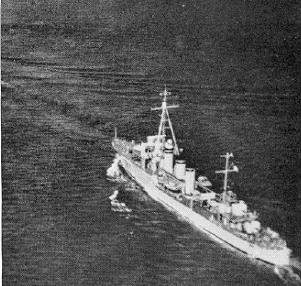
Orage was built at Chantiers Navals Français in Caen, laid down on 20 Aug 1923, launched 30 Aug 1924, commissioned on 1 Oct 1926 , comp. 1 Sep 1926, accepted 19 Jan 1927. She was sunk during Operation Dynamo on 23 May 1940.
 Ouragan
Ouragan

Ouragan was laid down on 7 September 1923, launched on 6 Dec 1924, and commissioned on 19 Jan 1927, completed on 15 Sep 1927. She was undergoing boiler repairs in a northern French port when the invasion started, so to escape capture (under Captain Patrice Brunet) she was towed by British tugs across the channel and to the Devonport Dockyard to complete readiness. She was seized on 3 July 1940 during Operation Catapult while moored in Plymouth. Later she was transferred to the Free Polish Navy on 17 July 1940 after being decommissioned but retransferred to the Free French on 30 April 1941. She took part in Atlantic escort operations, logs in research. She was decommissioned on 7 April 1949.
 Simoun
Simoun
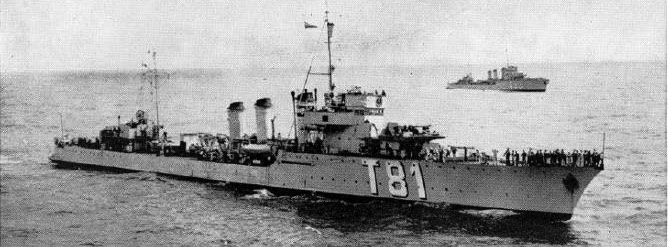
Simoun was ordered to Ateliers et Chantiers de St Nazaire-Penhoet in St. Nazaire, laid down on 8 Aug 1923, launched on 3 Jun 1924 and commissioned on 1 Jan 1926, completed on 29 April 1926, in service by Aug 1926. On 5 September 1939 she escorted a convoy of 11 passenger liners in the Atlantic, Mediterranean, and Far East. Convoy GC 1 was assembled off the Clyde with notably the Britannic (26,943 GRT), escorted from the morning of September 10th, by French TBs Le Fortune, La Railleuse and Simoun (Lt.Cdr. F. Hainguerlot) which departed Gibraltar to join the convoy. At 18:50 Simoun was sent back to Gibraltar with despatches. Simoun later proceeded again to rejoin the convoy. She was relieved near Malta on 14 September by HMS Greyhound to escort French convoy L2 (Sphinx, Ville de Strasbourg) which departed Marseilles on 12 September and joined the larger convoy underway to Beirut.
On 31 October, 1940 HMS Griffin spotted east of Gibraltar five Vichy French destroyers at 06:10, Bordelais, Brestois, L’Alcyon, Simoun and Tempête trying to pass the Strait of Gibraltar for Casablanca. HMS Renown, Barham, DD HMS Firedrake, Fortune, Fury, Greyhound departed Gibraltar westward to intercept. HMS Griffin shadowed them. However the interception was cancelled.
On 29 Mar 1941 HMS Sheffield escorted by HMS Faulknor, Fearless, Forester, Fury departed Gibraltar for a sweep towards Oran in search of Vichy-French merchant vessels. They spotted the convoy K 42 (Azrou, Bankok, Cap Varela, San Diego) escorted by Simoun. They took refuge in Nemours (now Ghazaouet) but HMS Fearless closed in to invertigate only to be repelled by shore batteries which were answered by HMS Sheffield, but they withdrew.
Later a French convoy was sent to Dakar and departed from there with the battleship Lorraine to Casablanca, escorted by Simoun and La Grandiere to escort her in. After she joined the allies she escorted Convoy GUS 21 (7 November 1943), another in Bizerta, Algiers, Oran and another on 18 November 1943, escorted by Simoun and minesweeping sloop Commandant Delage plus USS PC-480 to Gibraltar. She later escorted a Casablanca section. Missing logs for 1944-45. Long story short she survived the war and was BU in 1950.
 Sirocco
Sirocco
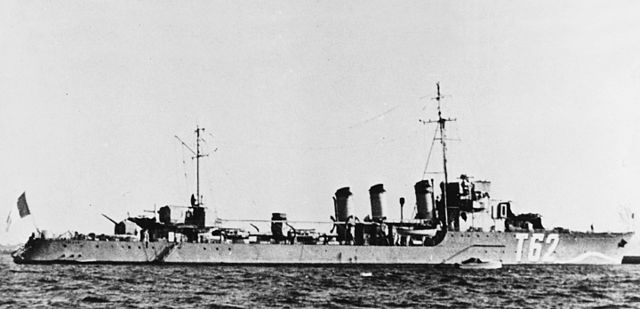
Sirocco was ordered on to AC St Nazaire, laid down on 15 Mar 1924, launched 3 Oct 1925, commissioned 1 Jul 1927, comp. 5 Feb 1928. She was sunk by E-boats S-23 and S-26 during Operation Dynamo, 31 May 1940.
 Tempête
Tempête
Tempête was laid down at Ateliers et Chantiers Dubigeon in Nantes on 3 Dec 1923, launched on 21 Feb 1925, commissioned on 20 Jul 1926, comp. 28 Sep 1926, in service that month. Served in the twi navies, decommissioned and scrapped in 1950.
 Tornade
Tornade
Tornade was laid down at Dyle et Bacalan in Bordeaux on 25 Apr 1923. She was launched on 12 Mar 1925 and completed on 1 Oct 1927. She was completed on 10 May 1928, in service on 21 May. On 5 Sept. 1939 she escorted liners bouned for the Atlantic, Mediterranean and Far East. On the 11th she was off Gibraltar with HMS Galatea, Tramontaine and Tornade under command of Lt.Cdr. R.G.A. Labat as well as Typhon (Lt.Cdr. Y.M.J. Le Hagre). She was relieved near Malta on 14 September 1939 by HMS Greyhound, Glowworm and later covered the French convoy L2 from Marseilles to Beirut. After June 1940 armistice she was now part of the Vichy French assets. No logs for 1941-42.
During Operation Torch in November 1942, two Bourrasque class DDs were seen leaving Oran, and were “greeted” by HMS Aurora, soon in action with HMS Boadicea and HMS Calpe, firing torpedoes at HMS Aurora. HMS Boadicea was hit forward, but Tornade was severely damaged and set on fire by a broadside, driven inshore while the other, Typhon, also badly hit at 07:27 fled back to Oran.
 Tramontane
Tramontane
Tramontane was laid down at Forges et Chantiers de la Gironde (FCG), Bordeaux on 29 Jun 1923, launched on 29 Nov 1924, commissioned on 15 May 1927, completed on 15 Oct 1927, in service by 1 Jan 1928. She was lost on 8 Nov 1942 during Operation Torch.
 Trombe
Trombe
Trombe was laid down at FCG on 5 Marche 1924, launched on 27 December 1925 and commissioned on 1 Jun 1927, completed 27 Oct 1927, in service by 21 Dec 1927.
On 7 Sept. 1939 whe escorted Convoy Green 1 from Gibraltar on 7 September 1939 to Suez, joined at 16:00 by French destroyers L’Alcyon (Lt.Cdr. V.A.M. Albertas) and Trombe (A.A.M. Lepotier). On 20 May 1940 she escorted the French battleships Bretagne (Capt. L.R.E. de Pivian) and Provence (Capt. G.T.E. Barois) from Alexandria to Bizerta with Tigre, Lynx, HMAS Stuart, Vampire, Voyager, Waterhen and were joined on 22 May by Bordelais and Trombe. She was scuttled in Toulon on 27 Nov 1942, passed onto the Italians but never made operational and decommissioned 17 Feb 1950.
 Typhon
Typhon
Typhon was laid down at FCG on 1 Sep 1923, launched on 22 May 1925, commissioned on 15 Feb 1928, completed 27 Jun 1928, in service 22 Oct 1928.
In Vichy French service she was caught by HMS Hartland’s assault on Oran harbour during Operation Torch. As HMS Walney entered Oran harbour at 03:10, Lt.Cdr. Billot, RN, waited five minutes before heading towards the harbour entrance, approached the smoke screen laid by ML 480 and a searchlight illuminated HMS Walney followed by a devastating fire from Ravin Blanc battery which killed nearly all her guns crews and blinded Lt.Cdr. Billot with a splinter. He still made it to the Quai de Dunkerque under point blank gunfire from Typhon laying alongside it. She eventually anchored until the French ceased fire so that she could be abandoned. Later HMS Walney and HMS Hartland entered in turn Oran Harbour supported by HMS Aurora northward. They destroyed the searchlight and engaged and sank Tramontaine. Around 06:00 they spotted two more leaving Oran, and soon they were targeted by HMS Aurora, HMS Boadicea and HMS Calpe. Tornade was driven ashore and beached, abandoned, and Typhon fled back in port. At 10:24 she was engaged by HMS Jamaica and HMS Aurora alonsgide Epervier and beached.
Read More/Src
Books
Campbell, John (1985). Naval Weapons of World War II. Annapolis NIP
Cernuschi, Enrico & O’Hara, Vincent P. (2013). “Toulon: The Self-Destruction and Salvage of the French Fleet”. Conway.
Colledge, J. J. & Adams, T. A. (May 2022). “French Ships Seized by the Royal Navy During the Second World War — Part 2”.
Gröner, Erich (1990). German Warships: 1815–1945. Vol. 1: Major Surface Warships. NIP
Jordan, John & Moulin, Jean (2015). French Destroyers: Torpilleurs d’Escadre & Contre-Torpilleurs 1922–1956. Seaforth Publishing.
Roberts, John (1980). “France”. In Chesneau, Roger (ed.). Conway’s All the World’s Fighting Ships 1922–1946. Mayflower Books.
Rohwer, Jürgen (2005). Chronology of the War at Sea 1939–1945: The Naval History of World War Two (Third Revised ed.). NIP.
Whitley, M. J. (1988). Destroyers of World War Two: An International Encyclopedia. NIP.
Links
https://web.archive.org/web/20090517133903/http://bpcmistral.fr/index.php/2007/03/17/15-mistral-un-nom-une-histoire
https://uboat.net/allies/warships/class/285.html
http://www.navypedia.org/ships/france/fr_dd_bourrasque.htm
https://en.wikipedia.org/wiki/Bourrasque-class_destroyer
https://www.worldnavalships.com/bourrasque_class.htm
http://dreadnoughtproject.org/French%20Warship%20Plans/

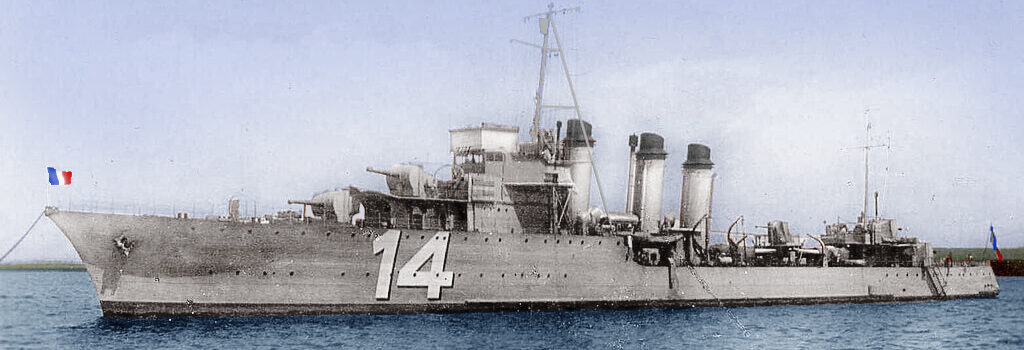
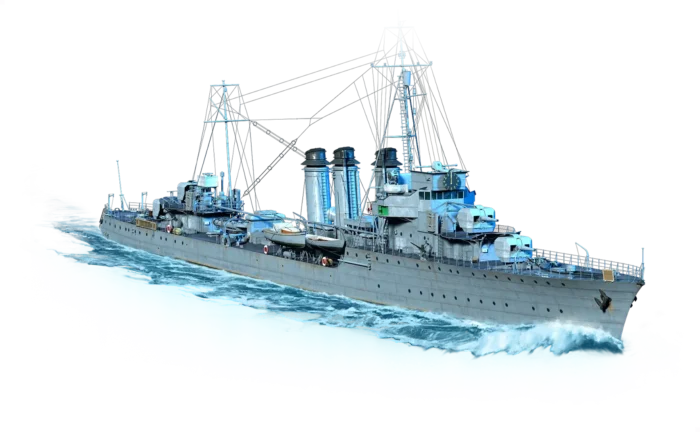
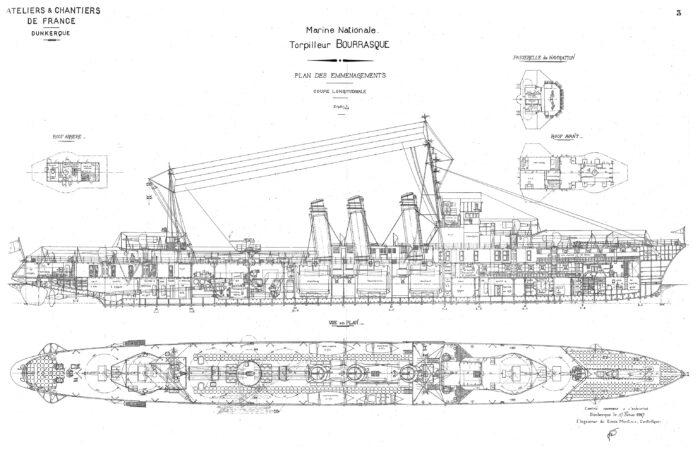
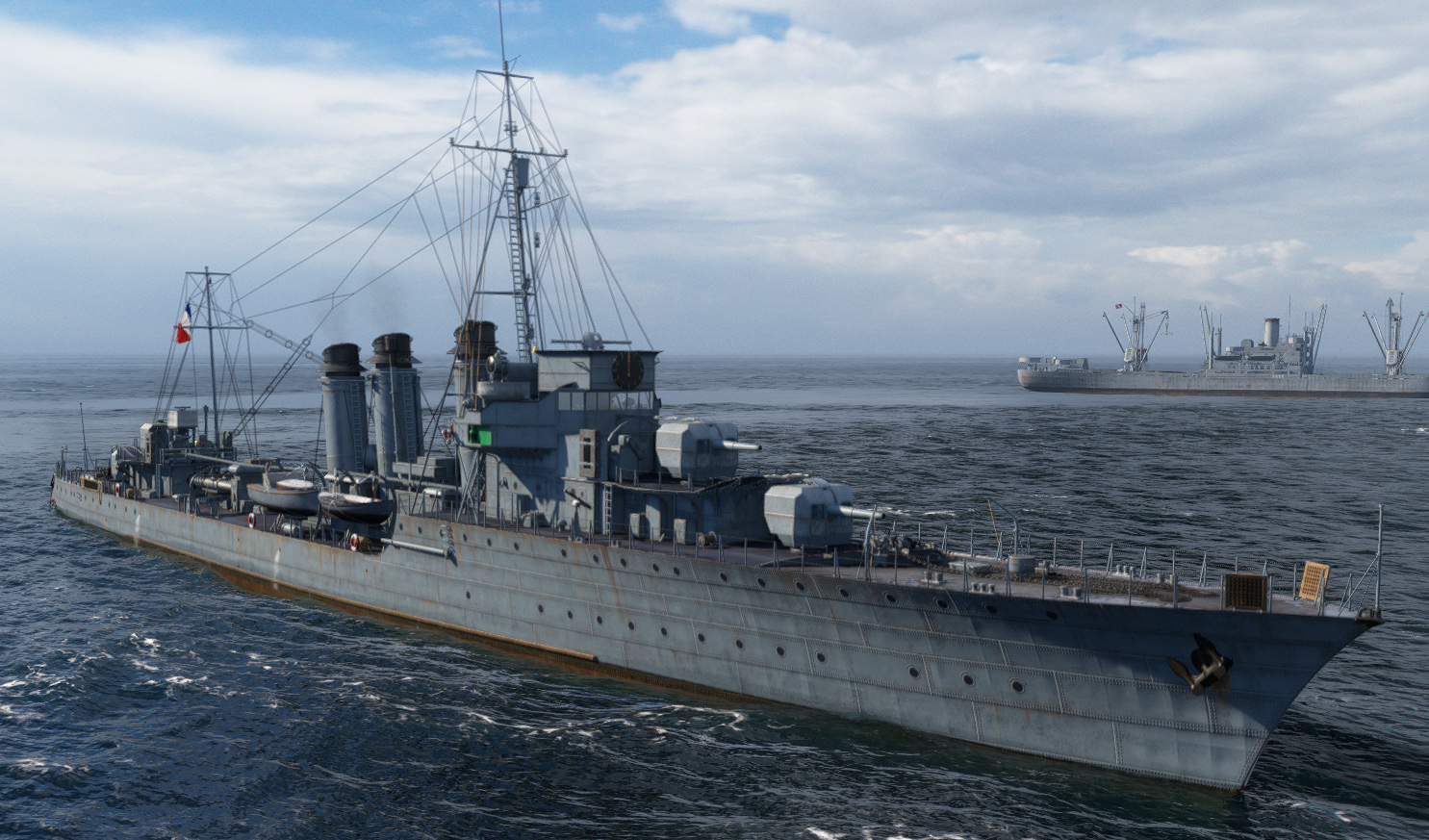
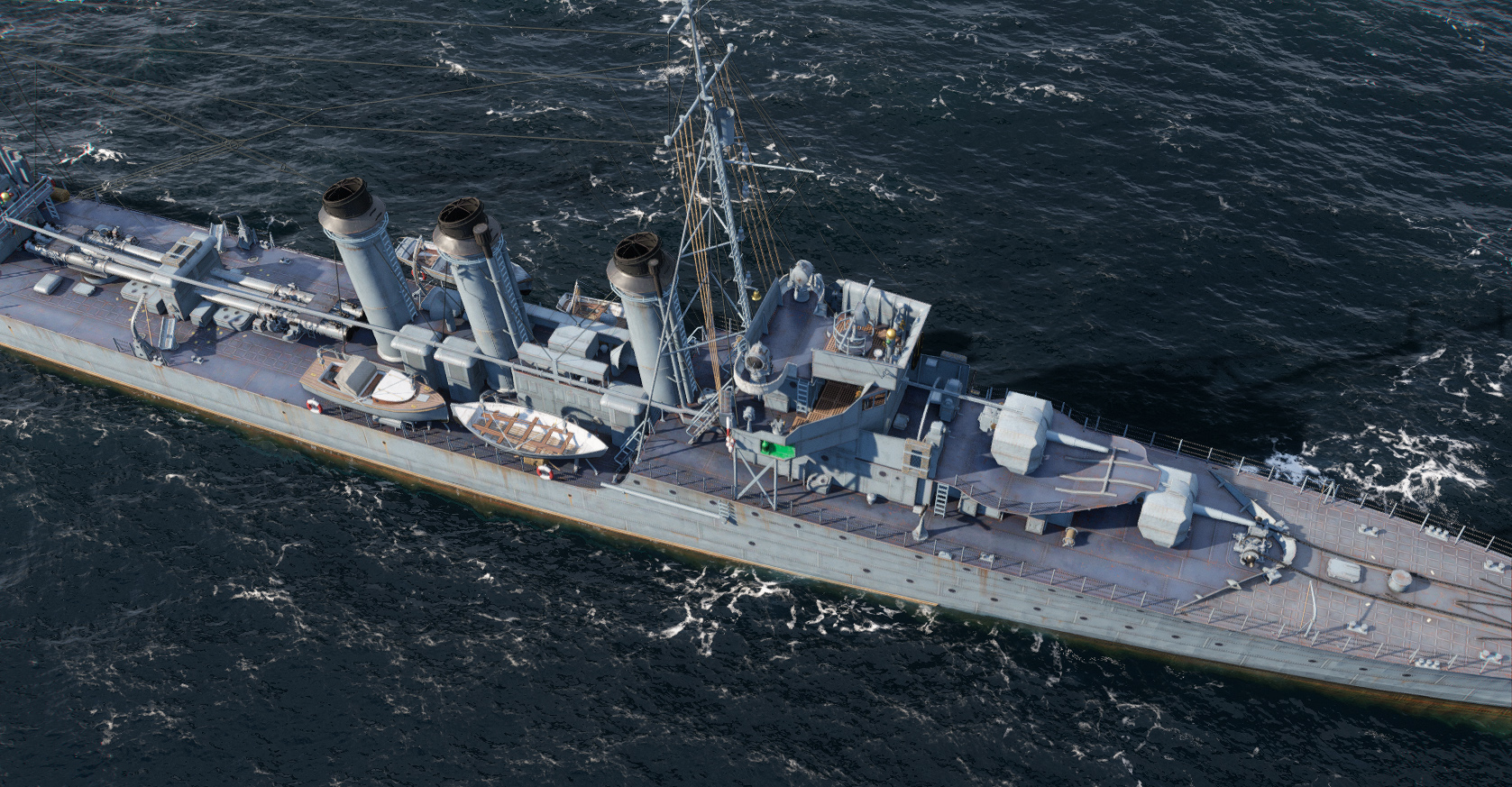
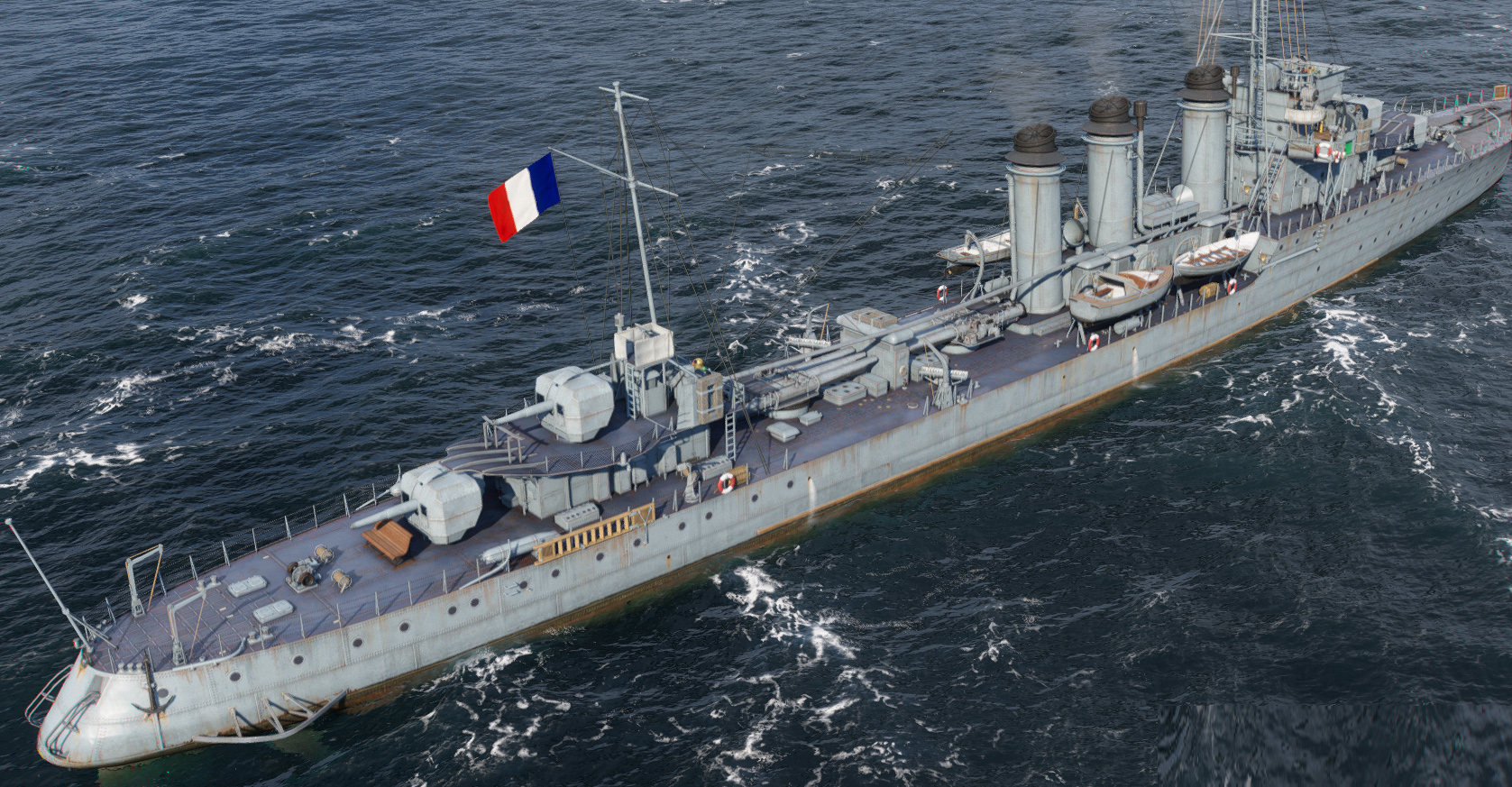
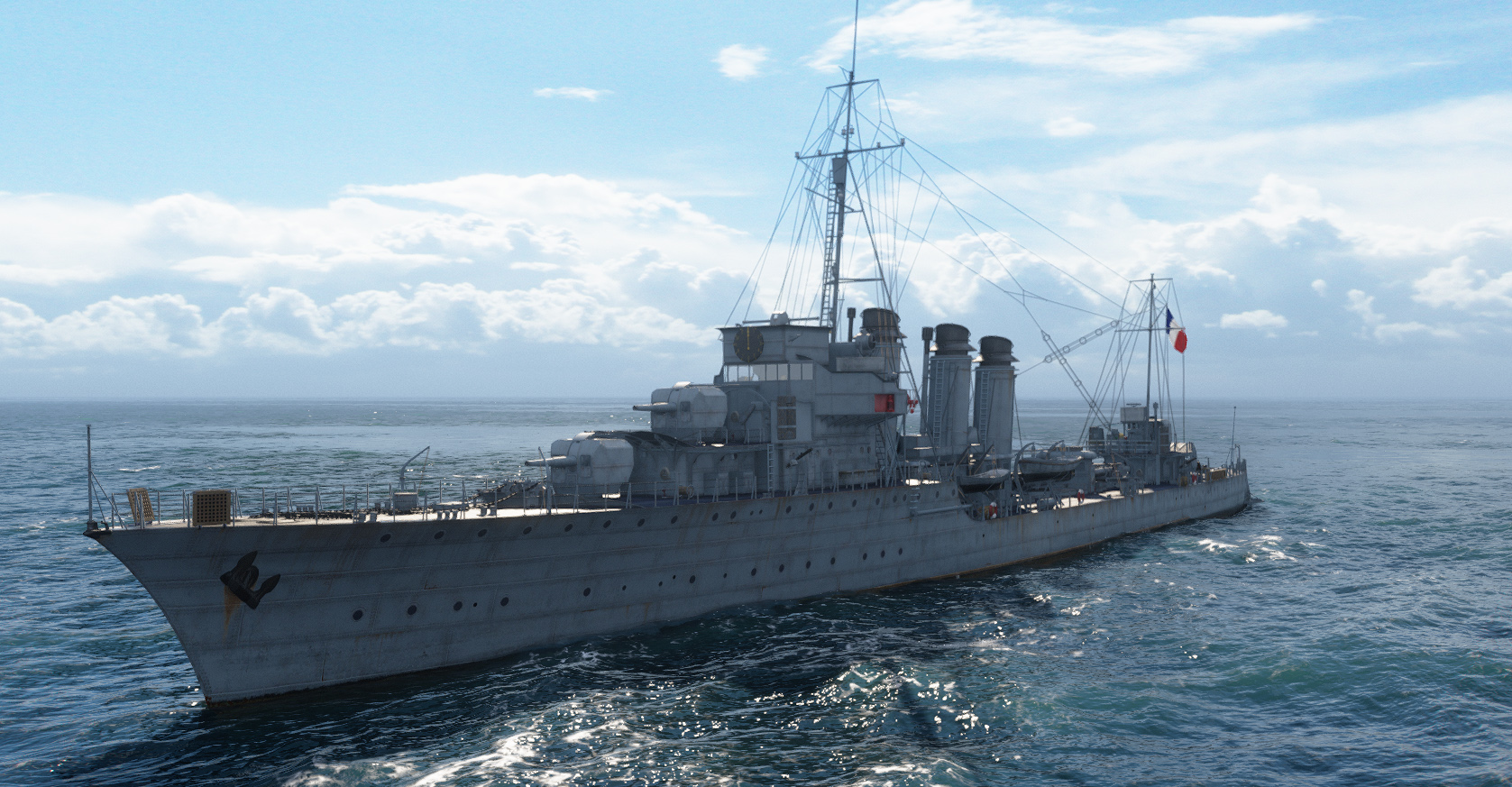

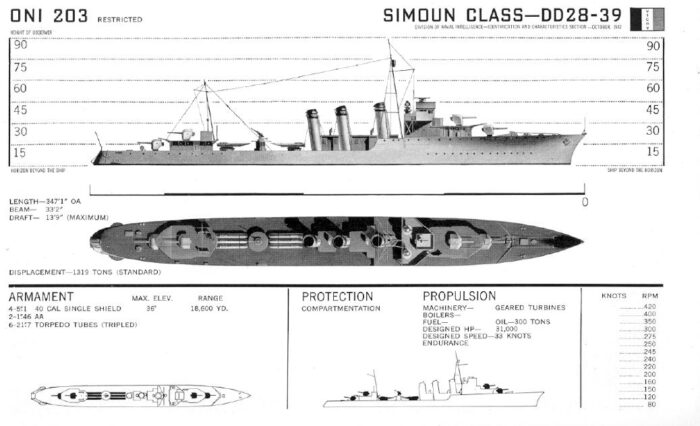
 Latest Facebook Entry -
Latest Facebook Entry -  X(Tweeter) Naval Encyclopedia's deck archive
X(Tweeter) Naval Encyclopedia's deck archive Instagram (@navalencyc)
Instagram (@navalencyc)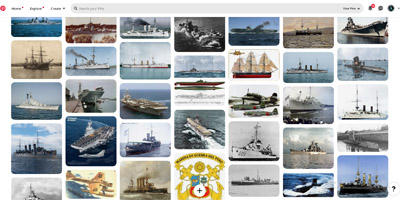

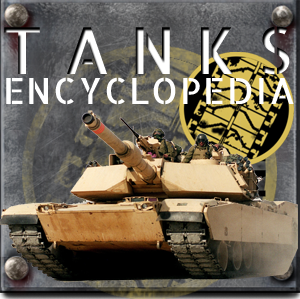
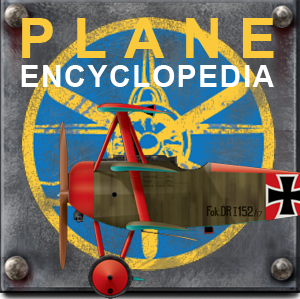
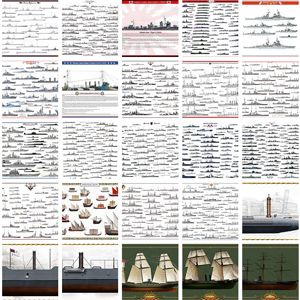
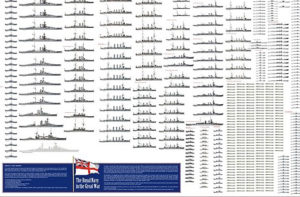
 French Navy
French Navy Royal Navy
Royal Navy Russian Navy
Russian Navy Armada Espanola
Armada Espanola Austrian Navy
Austrian Navy K.u.K. Kriegsmarine
K.u.K. Kriegsmarine Dansk Marine
Dansk Marine Nautiko Hellenon
Nautiko Hellenon Koninklije Marine 1870
Koninklije Marine 1870 Marinha do Brasil
Marinha do Brasil Osmanlı Donanması
Osmanlı Donanması Marina Do Peru
Marina Do Peru Marinha do Portugal
Marinha do Portugal Regia Marina 1870
Regia Marina 1870 Nihhon Kaigun 1870
Nihhon Kaigun 1870 Preußische Marine 1870
Preußische Marine 1870 Russkiy Flot 1870
Russkiy Flot 1870 Svenska marinen
Svenska marinen Søværnet
Søværnet Union Navy
Union Navy Confederate Navy
Confederate Navy Armada de Argentina
Armada de Argentina Imperial Chinese Navy
Imperial Chinese Navy Marinha do Portugal
Marinha do Portugal Mexico
Mexico Kaiserliche Marine
Kaiserliche Marine 1898 US Navy
1898 US Navy Sovietskiy Flot
Sovietskiy Flot Royal Canadian Navy
Royal Canadian Navy Royal Australian Navy
Royal Australian Navy RNZN Fleet
RNZN Fleet Chinese Navy 1937
Chinese Navy 1937 Kriegsmarine
Kriegsmarine Chilean Navy
Chilean Navy Danish Navy
Danish Navy Finnish Navy
Finnish Navy Hellenic Navy
Hellenic Navy Polish Navy
Polish Navy Romanian Navy
Romanian Navy Turkish Navy
Turkish Navy Royal Yugoslav Navy
Royal Yugoslav Navy Royal Thai Navy
Royal Thai Navy Minor Navies
Minor Navies Albania
Albania Austria
Austria Belgium
Belgium Columbia
Columbia Costa Rica
Costa Rica Cuba
Cuba Czechoslovakia
Czechoslovakia Dominican Republic
Dominican Republic Haiti
Haiti Hungary
Hungary Honduras
Honduras Estonia
Estonia Iceland
Iceland Eire
Eire Equador
Equador Iran
Iran Iraq
Iraq Latvia
Latvia Liberia
Liberia Lithuania
Lithuania Mandchukuo
Mandchukuo Morocco
Morocco Nicaragua
Nicaragua Persia
Persia San Salvador
San Salvador Sarawak
Sarawak Uruguay
Uruguay Venezuela
Venezuela Zanzibar
Zanzibar Warsaw Pact Navies
Warsaw Pact Navies Bulgaria
Bulgaria Hungary
Hungary

 Bundesmarine
Bundesmarine Dutch Navy
Dutch Navy Hellenic Navy
Hellenic Navy Marina Militare
Marina Militare Yugoslav Navy
Yugoslav Navy Chinese Navy
Chinese Navy Indian Navy
Indian Navy Indonesian Navy
Indonesian Navy JMSDF
JMSDF North Korean Navy
North Korean Navy Pakistani Navy
Pakistani Navy Philippines Navy
Philippines Navy ROKN
ROKN Rep. of Singapore Navy
Rep. of Singapore Navy Taiwanese Navy
Taiwanese Navy IDF Navy
IDF Navy Saudi Navy
Saudi Navy Royal New Zealand Navy
Royal New Zealand Navy Egyptian Navy
Egyptian Navy South African Navy
South African Navy






























 Ukrainian Navy
Ukrainian Navy dbodesign
dbodesign